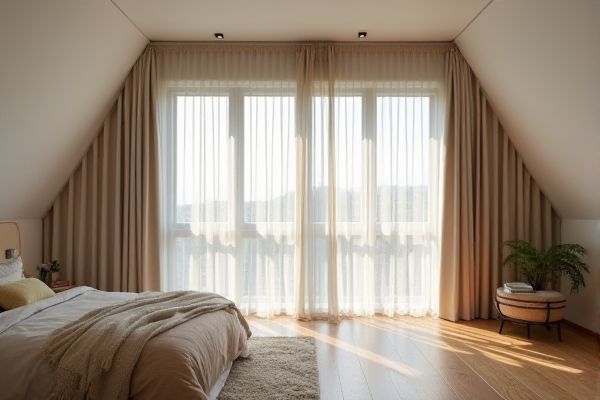
An attic curtain divider offers a flexible, space-saving solution that can be customized to fit unique sloped ceilings and irregular spaces, while a folding screen provides a portable, decorative barrier that's easy to move and rearrange. Discover the pros and cons of each option to determine which best suits your attic transformation needs.
Table of Comparison
| Feature | Attic Curtain Divider | Folding Screen |
|---|---|---|
| Purpose | Separate attic space with fabric | Create a portable room partition |
| Material | Lightweight fabric, often sheer or opaque | Wood, metal, fabric, or vinyl panels |
| Installation | Mounted on curtain rods or tracks | Freestanding, no installation needed |
| Portability | Fixed unless removed | Highly portable and foldable |
| Space Efficiency | Minimal footprint, uses vertical space | Requires floor space when set up |
| Light Control | Blocks or filters light depending on fabric | Generally blocks view but varies by material |
| Privacy | Moderate, depends on fabric opacity | High, solid panels ensure privacy |
| Design Flexibility | Wide range of colors and fabrics | Variety of styles, patterns, and materials |
| Cost | Usually lower cost | Varies, generally higher than curtains |
| Maintenance | Machine washable or replaceable fabric | Requires cleaning of frames and panels |
Introduction: Defining Attic Curtain Dividers and Folding Screens
Attic curtain dividers are fabric panels designed to separate attic spaces, enhancing privacy and controlling light without permanent construction. Folding screens consist of hinged frames with panels that stand independently, allowing flexible room division and easy repositioning. Both serve as practical solutions for segmenting spaces but differ in installation, mobility, and aesthetic impact.
Space Optimization in Attic Rooms
Attic curtain dividers provide flexible, lightweight solutions for space optimization in attic rooms, allowing you to easily partition areas without permanent structures. Folding screens offer portable, decorative options but typically require more physical space to function effectively. Choosing an attic curtain divider maximizes limited square footage by enabling seamless room customization and enhancing natural light flow.
Installation Process: Curtain Divider vs Folding Screen
Attic curtain dividers offer a straightforward installation process, typically requiring only a tension rod or ceiling-mounted track to hang the fabric, making them adaptable to various attic spaces. Folding screens require no installation but must be positioned carefully to fit the uneven layout of attic areas, offering quick mobility but limited structural support. Your choice between the two depends on whether you prioritize ease of setup or flexible, freestanding room division.
Cost Comparison: Budgeting for Privacy Solutions
Attic curtain dividers offer a cost-effective privacy solution with prices typically ranging from $50 to $150 depending on fabric quality, making them ideal for tight budgets. Folding screens vary widely in cost, from $100 for basic models to over $400 for designer options, reflecting materials like wood, metal, or decorative panels. Choosing between an attic curtain divider and a folding screen depends on budget constraints, desired aesthetics, and long-term investment plans for privacy enhancement.
Style and Design Versatility
Attic curtain dividers offer a sleek, flexible solution that complements various interior styles, adapting easily to both modern and rustic attic spaces. Folding screens provide a more structured, decorative element that can introduce patterns or textures, enhancing design versatility with movable panels. Your choice depends on whether you prioritize seamless integration or statement-making decor in your attic layout.
Privacy and Light Control Effectiveness
An attic curtain divider offers superior privacy and customizable light control through adjustable fabric options, making it ideal for spaces requiring variable ambiance. Folding screens provide moderate privacy but often have gaps between panels, allowing more light to filter through and reducing their effectiveness for full light blocking. Your choice depends on the balance needed between flexibility in light control and the level of privacy desired.
Durability and Maintenance Considerations
Attic curtain dividers, made from fabric materials such as heavy-duty polyester or canvas, offer durability but require regular cleaning to prevent dust accumulation and potential mildew in humid attic environments. Folding screens, often constructed from wood, metal, or composite materials with fabric or woven panels, provide a more rigid and long-lasting structure, needing less frequent maintenance beyond occasional dusting and hinge lubrication. Choosing between the two depends on factors like exposure to attic temperature fluctuations and ease of cleaning to ensure long-term usability.
Flexibility: Temporary vs Permanent Solutions
Attic curtain dividers offer flexible, temporary solutions that can be easily installed and removed to accommodate changing space needs or seasonal adjustments. Folding screens provide more permanent room division with sturdy construction and decorative appeal, making them ideal for long-term use. Choosing between these options depends on the desired balance between adaptability and durability in attic space management.
Best Use Cases for Attic Curtain Dividers
Attic curtain dividers provide a flexible and space-saving solution ideal for creating temporary or adjustable partitions in small or irregular attic spaces where traditional folding screens may be cumbersome. These curtain dividers offer ease of installation on ceiling-mounted tracks, allowing you to control light, privacy, and airflow without sacrificing valuable floor space. Choosing an attic curtain divider enhances your ability to customize and maximize the functionality of your attic, especially in areas with low ceilings or awkward shapes.
Best Use Cases for Folding Screens
Folding screens are ideal for creating temporary, flexible partitions in open living spaces, providing privacy without permanent installation. These lightweight, portable dividers work well in studios, bedrooms, or offices where space reconfiguration is frequent and easy storage is needed. Unlike attic curtain dividers, folding screens add a decorative element, making them suitable for visual interest and style enhancement.
 homyna.com
homyna.com